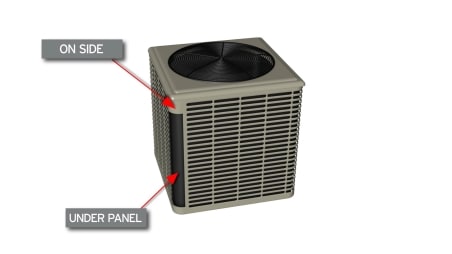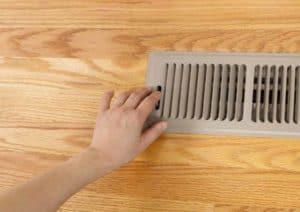Before turning on your central air system for the season ensure the system is turned off at the circuit breaker, and maintains at least two feet (half a meter) of space between the unit and any surrounding shrubbery, trees, or flowers for adequate airflow. Also, ensure there’s at least eight feet of clearance above the condensing unit. For optimal performance, consider replacing the air filters by shopping for them here. Following these steps will help keep your central air conditioning system operating efficiently and effectively.
1. Read the owner’s manual and brush up on how it works.
2. Inspect the condensing unit. (The condensing unit is the unit that sits outside and has several fins that draw in air from the outside.)
• Check the condensing unit for animal and insect nests. Relocate the homes of critters such as mice and birds. Remove insect nests.
• Look for damage.
3. Remove debris from inside and outside of the condensing unit.
• Use a garden hose to clear twigs, leaves and other debris that may have settled inside. A long-handled condenser coil-cleaning brush makes it easier to reach inside; take great care, though, not to damage the coils.
For adequate air flow, make sure that there’s at least two feet (half a meter) of space between the unit and any shrubbery, trees or flowers. There should be at least eight feet of clearance above the condensing unit.
4. Replace or clean the furnace or air handler filter.
This should happen at least every three months. If you or your family have allergies, you may need to change this more frequently. A dirty air filter causes the system to waste a lot of energy. It also degrades the quality of your home’s air.
5. Check out the ductwork.
Look for issues on the connections and seams; they should be sealed tightly.
6. Inspect registers.
Use a flashlight for a better look at your vent registers. People frequently find earrings, coins and other small objects here. Remove those objects and use a vacuum attachment to remove dust and dirt. For proper air circulation, make sure no rugs, drapes or furniture are blocking the registers.
7. Power on the system at the circuit breaker and then test system controls.
Run the air conditioner through a start and stop cycle to ensure its safe operation and that it powers off properly.
8. Make living changes in your home.
Put away thick bathrobes and sweatshirts. Opt for lighter, more spring-like lounge wear. This simple change may enable you to keep the thermostat at a temperature a few degrees higher. Install a ceiling fan for use on cooler evenings in lieu of the central air to save energy.
9. If there are changes in performance, troubleshoot right away.
If your central air is noisy or isn’t cooling, troubleshoot and learn how to fix it. Enter your central air conditioning system’s condensing unit model number on RepairClinic.com for free troubleshooting and how-to repair help.

Related information
Central air conditioning system maintenance tips
19 simple ways to reduce energy consumption and save money this summer
9 simple ways to reduce energy consumption
Seven things you’re wasting money on in your home
